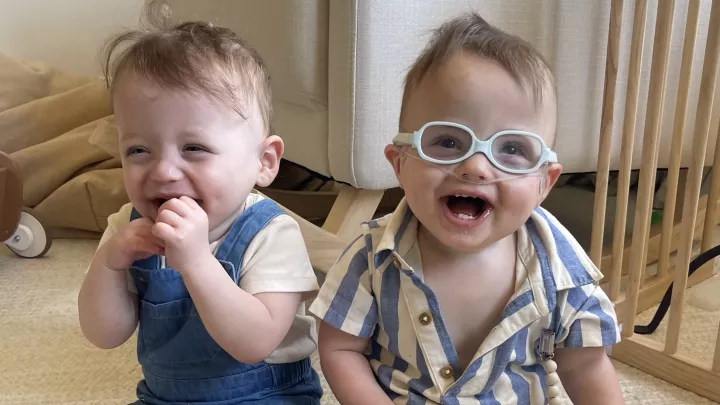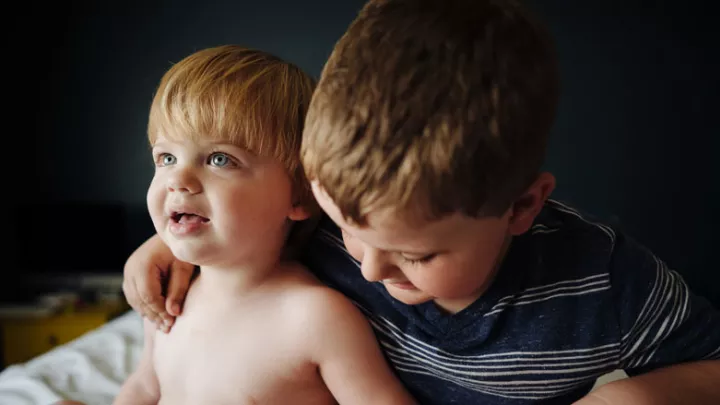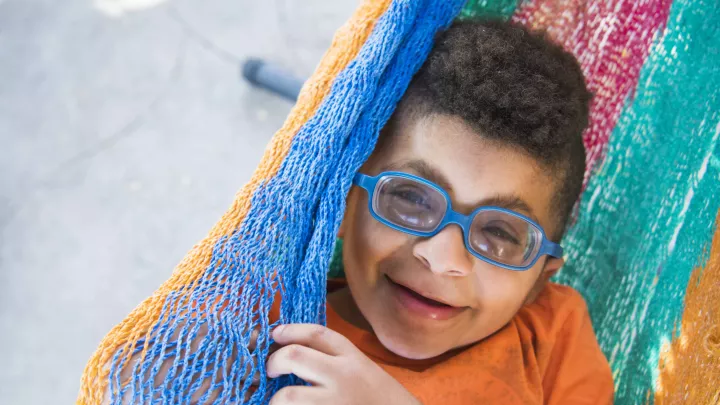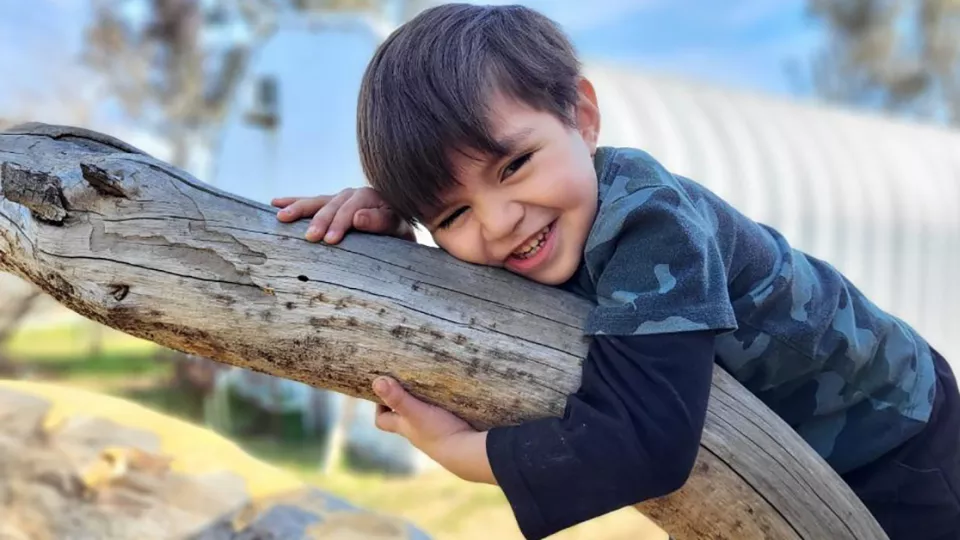
After ECMO, Nothing Can Stop Martin
“Did you get a picture of your baby yet?”
Imelda looked up, startled by the nurse’s question. At her side, her newborn baby, Martin, lay in an incubator, with what seemed like a million tubes coming out of his little body. A heart-lung machine called extracorporeal membrane oxygenation (ECMO) had been keeping him alive since he was born.
“I don’t want a photo,” Imelda told her, shaking her head. “I don’t want to remember my son like this.”
“Oh, that picture is not for you,” the nurse responded. “It’s for your son. Because when he gets older and he’s struggling through something, you’re going to show him a picture of him on this machine, and you’re going to say, ‘Honey, if you can get through this, you can get through anything. There’s nothing that can stop you.’”
A traumatic birth
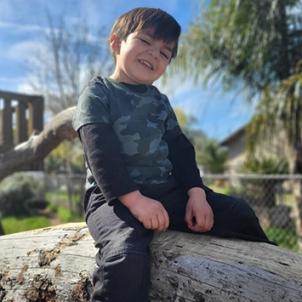
Just a few days earlier, Imelda had been at home, timing her contractions at 3 a.m. and watching them get faster and stronger. That in itself was not alarming; she was 40 weeks pregnant. Still, she couldn’t shake the sense that something was terribly wrong.
“I just had this feeling in my heart,” she says. “I told my husband, ‘We need to leave right now.’”
At the hospital, her fears were confirmed. The baby was in distress; his heart rate was dropping dangerously. Doctors rushed to perform an emergency C-section. But when Martin was born, there was no telltale cry. He was completely limp.
“What’s wrong?” Imelda cried. “What’s wrong with my baby?”
The team whisked him away. Fortunately, doctors were able to insert a tube into Martin’s trachea and connect him to a ventilator, allowing him to start breathing. But he had been without oxygen for a dangerous two to three minutes.
“On a scale of 1 to 100, with 100 being the worst, your baby is a 99,” a doctor told Imelda and her husband, Armando. “He needs to go to Children’s Hospital Los Angeles immediately.”
Time is brain
Martin had hypoxic-ischemic encephalopathy (HIE), a brain injury that occurs when a baby lacks oxygen during delivery. His case was severe. Every second counted to save his brain cells.
An emergency transport team from CHLA quickly arrived and started Martin on critical medicines, as well as therapeutic hypothermia. Hypothermia lowers a baby’s body temperature and can reduce the risk of brain injury from HIE, especially when started right away.
“It’s critical to cool the brain as quickly as possible after birth,” explains Tai-Wei Wu, MD, Director of the Neonatal Neuroprotective Program at CHLA. “That gives us the best chance to preserve a baby’s brain cells.”
But Martin also had meconium aspiration syndrome, which occurs when a baby poops before birth. The meconium mixes with amniotic fluid, and the thick, tar-like substance is inhaled into the lungs. Meconium aspiration often occurs when there is fetal distress before the baby is born.
At CHLA, doctors in the Level IV Steven & Alexandra Cohen Foundation Newborn and Infant Critical Care Unit (NICCU) quickly determined that only an extreme measure—ECMO—could save Martin’s life.
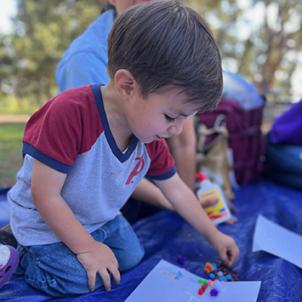
“The ventilator and medications were not enough to raise his oxygen levels,” says Rachel Chapman, MD, Associate Division Chief of Neonatology in the Fetal and Neonatal Institute and Medical Director of the Cohen Foundation NICCU. “ECMO was his only chance.”
ECMO is an advanced form of heart-lung support, and CHLA has the largest pediatric program in California. The specialized team includes neonatologists, pediatric surgeons, nurses and respiratory therapists who have extensive experience in providing round-the-clock care for babies on this complex heart-lung support.
That expertise enabled the team to immediately mobilize and place Martin on ECMO just a few hours after his arrival. “Time is brain,” Dr. Wu notes. “This was a baby who was not getting enough oxygen. The longer that goes on, the greater an effect it has on the brain. We had to act fast.”
The team was also able to continue Martin’s hypothermia treatment while he was on ECMO. Still, his prognosis was bleak.
“Even with hypothermia, 60% of babies with severe hypoxic brain injuries like Martin’s do not survive or have severe neurodevelopmental impairment,” Dr. Wu says. “And ECMO carries high risks of brain bleeds and stroke.”
Beep! Beep! Beep!
The next day, Imelda was released from the hospital and joined Armando at Martin’s bedside.
“I walked in, and there were just tubes everywhere,” she remembers. “And alarms. Alarms for hours on end. Beep! Beep! Beep! The nurses were moving, like, fast. They were working so hard! They were trying to keep him alive and suction the meconium out of his lungs. I was in awe.”
A multidisciplinary team of specialists—including neonatologists, pediatric surgeons, pulmonologists, neurologists, nephrologists and cardiologists—collaborated on his care. When Martin began having seizures, for example, the team’s 24-hour video EEG monitoring identified them, enabling neuro critical care specialists to quickly treat them with medication.
Meanwhile, Imelda and Armando found themselves transfixed on the many monitors surrounding their son, watching anxiously as numbers seemed to randomly zigzag up and down.
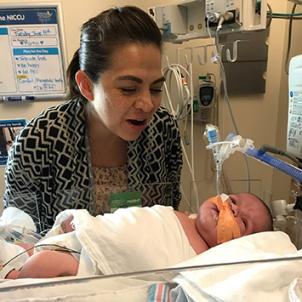
“Dr. Chapman came into the room at one point,” Imelda remembers. “And she just hugged me and said, ‘Let us worry about the monitors. Just look at your son. Just be with him.’
“The doctors and nurses at CHLA are amazing,” Imelda adds. “Their words are like little gems, little treasures that keep you going.”
‘He wanted to live’
When Martin reached his sixth day on ECMO, Dr. Chapman came in with good news: His lungs were improving. The plan was to slowly start weaning him from the machine later that day.
His parents celebrated. But not for long.
Two hours later, Martin’s condition turned: He had a small stroke. There would be no gradual weaning—the team had to immediately take him off ECMO. If his lungs could not handle it, there would be nothing more they could offer him.
“Just pray,” Imelda told her husband. “Pray, pray, pray.”
The team carefully removed Martin from ECMO. He needed full ventilator support and many medications. But he hung on.
“He’s a little fighter,” his mom says. “He wanted to live.”
For the next several weeks, Martin slowly improved. First, he weaned off the ventilator. After a couple of weeks, there was another milestone: His parents were able to hold him for the first time.
Finally, after two months in the hospital, he went home. He was on oxygen 24/7. He had a feeding tube. His struggles were not over.
But he was home.
A daily reminder
“Helloooo!”
A little boy with a cardboard box over his head has come alongside Imelda, who is talking by Zoom. The box has two Batman-shaped holes for eyes. The boy lifts up the box to reveal a huge smile. It is Martin.
“He was so excited to show you his robot costume,” his mom says, laughing.
“It’s not a robot costume,” Martin corrects her. “It’s a box with eyes on it.”
“Yes,” she says, smiling down at him. “It’s a box with eyes on it.”
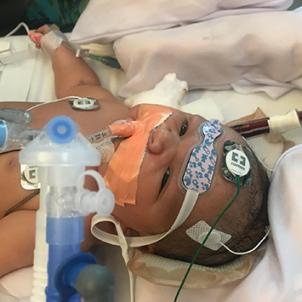
Now 4 and a half, Martin is thriving. An energetic preschooler, he runs, climbs, swims, sings, talks up a storm and charms everyone he meets.
“He’s got that magnetism,” Imelda says. “He is a happy, happy, happy boy. We are so grateful. If it weren’t for CHLA, our son would not be here.”
His recovery was slow but steady. A few months after coming home, he no longer needed the feeding tube. Gradually, he needed less oxygen support, too, and by age 18 months he didn’t need it at all.
Doctors at CHLA followed him closely through the Newborn Follow-up Program, which provides comprehensive care for babies after a critical illness. And while Martin underwent occupational therapy for his right hand, which is weaker because of the stroke, he was walking before his first birthday. And even the hand weakness doesn’t hold him back.
“No one else notices it,” Imelda says. “He is a total lefty.”
His doctors have been amazed by his recovery. “He had such a rough start,” says Dr. Wu. “It’s quite humbling to see him now—so bright and curious and active. It shows how plastic the brain can be.”
It also is a testament to CHLA’s lifesaving care. In gratitude, Imelda created posters with pictures of Martin and shared them with Dr. Wu, Dr. Chapman and one of Martin’s former nurses.
“I look at it every day!” Dr. Chapman shares. “His recovery has been remarkable. It’s a daily reminder of why we do what we do.”
And that picture of Martin on ECMO? Yes, Imelda heeded that nurse’s advice and ended up taking several photos. Right now, her son is too busy playing with his older sister and parading his latest collection of superhero action figures.
But one day, she will show the photos to him—and remind him that he’s always been a fighter. That he can get through anything. And that nothing can stop him.
